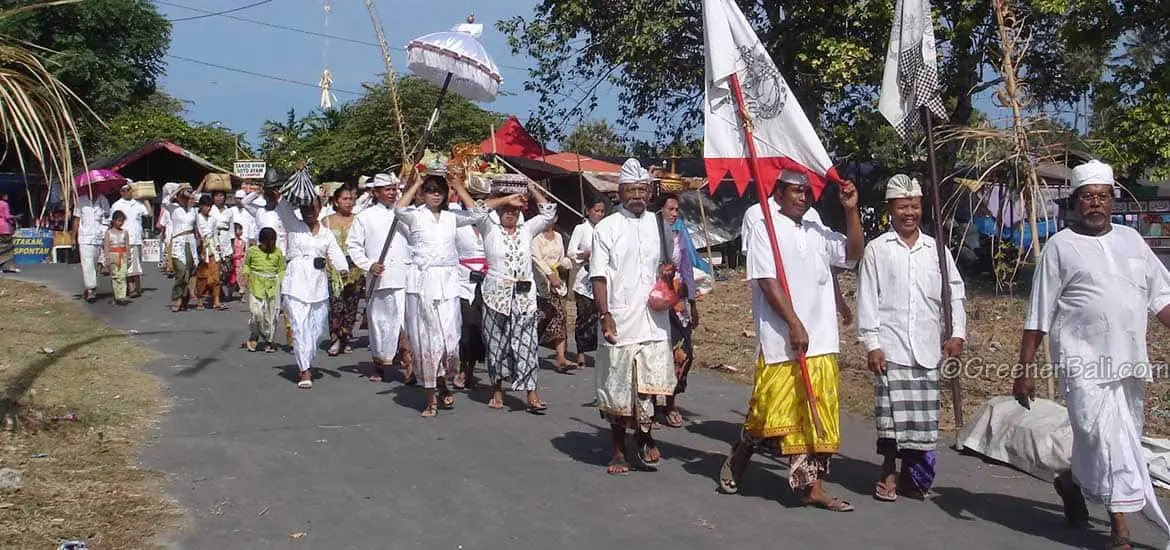There are always religious Bali festivals going on. The daily life of the Balinese seems to be revolved around preparing and conducting ceremonies for these temple festivals.
It’s so time-consuming that it can be considered a full-time job.
But of course, the Balinese don’t see it as a job. For them, these spiritual festivals are part of life. Without it, their life cycle, social structure, and connection with the heavenly world will be incomplete.
So it comes as no surprise that there always seems to be a ritual taking place according to the Full Moon, a new calendar year or other days which are considered important.
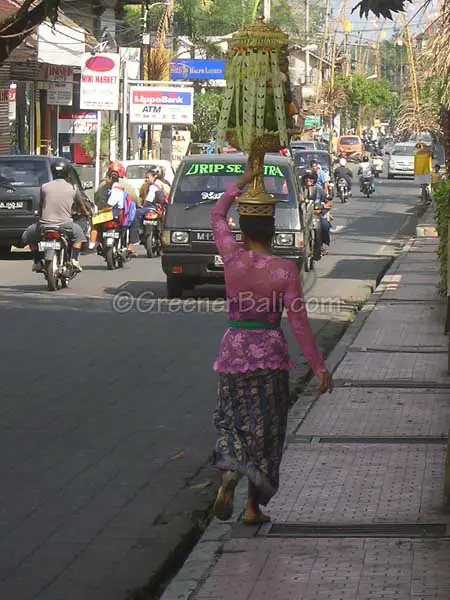
The major religious Bali festivals on the island are:
1. Galungan and Kuningan
2. Nyepi
3. Odalan
4. Temple Ceremonies
5. Other annual events
1. Galungan and Kuningan
Galungan is considered a celebration of the new year based on the Wuku Calendar. This means that this is one of the festivals which is celebrated every 210 days.
It’s a 10-day festival which celebrates the victory of good over evil.
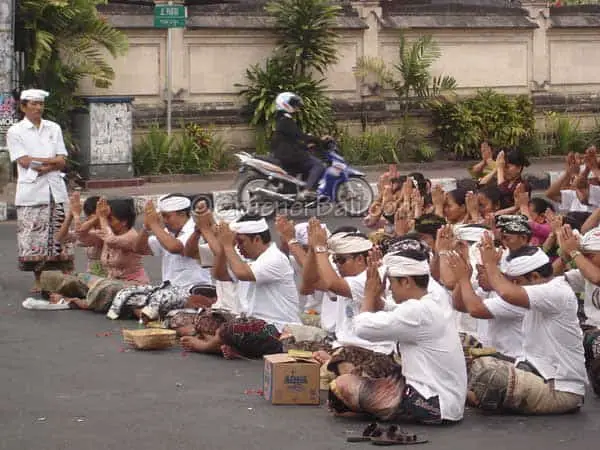
During this period of time, the ancestral spirits come down to join the Galungan festivities, to receive offerings and to visit the homes of their descendants. Then, at the end of the 10 days, the spirits return back to heaven to await the next Galungan.
During these important days, every Balinese home is covered with special offerings and everything is cleaned for this occasion.
Streets are also decorated with penyors which are tall bamboo poles decorated with long strings of palm leaves. The tips of the penyors often bend over the streets which create a nice arch for traffic to pass by. I have heard that the Balinese place the penyors during Galungan so the gods who reside in the mountains can see it from far away.
During this Balinese event, grand feasts are prepared together with a lot of offerings. Balinese conduct many prayers during this time as well. On the Galungan day itself (to be exact the 5th day of the 10 days celebration) the Balinese gather together with their family to pray and to make offerings.
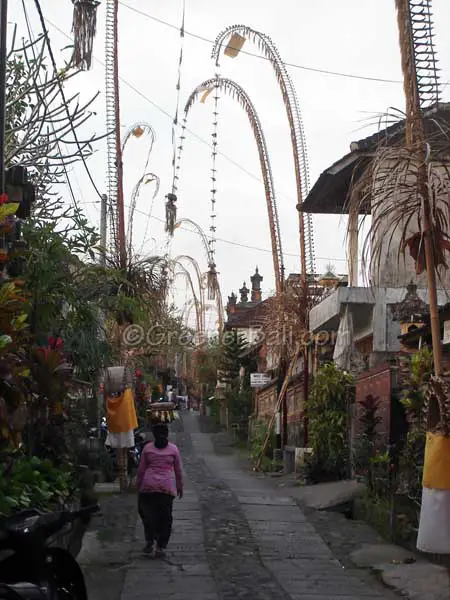
The next day which is called Manis Galungan, the Balinese go out to visit their friends.
Kuningan
Kuningan follows straight after the 10 days of Galungan. This is also one of the most important days as the spirits of the ancestors return to heaven. And like all Balinese festivals, this is accompanied by praying and again with a lot of offerings.
2. Melasti and Nyepi
Unlike all other festivals, Melasti and Nyepi are determined through the Hindu Saka Calendar and not through the Wuku. It is the Saka New Year which usually falls in March of April and consists mainly of many important purification rituals.
Melasti is held one day before the Nyepi Festival. It is a day full of ceremonies called Pratima. Dressed at their best, men come together and play Balinese instruments. Others purify religious temple objects with water from sacred springs or the sea and make offering offerings to the Ogoh-Ogoh (huge paper mache monster) which will be guided through town in the evening.
This loud spectacle is a huge contrast to Nyepi, which is held the next day. The Balinese go to the streets with drums, gongs, firecrackers, and the Ogoh-Ogoh so they can scare off all the evil spirits that roam the island.
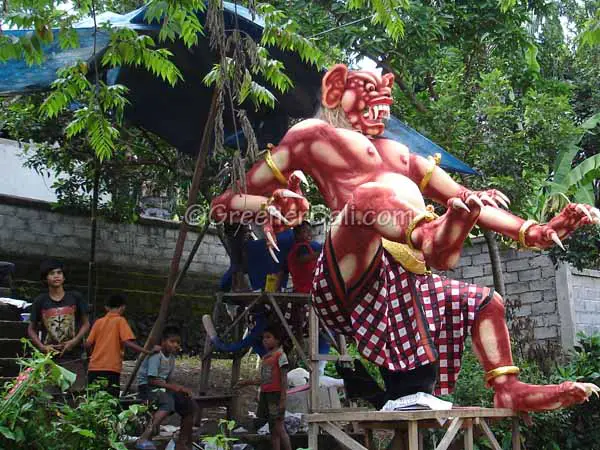
Once it is Nyepi a silent blanket covers the island. Everyone sits quietly at home to convince the remaining evil spirits that everybody has left the island.
This does not only mean the Balinese have to be quiet, but everyone on the island must not make any noise. This includes travelers who are spending their holiday in Bali.
No exceptions…
Everywhere shops, restaurants, and other attractions will be closed for the day. Electricity (including the internet) will be turned off as well.
If you are in Bali on this specific Nyepi day, be prepared to do nothing whatsoever. Of all the festivals, this is the quietest one. So bring a good book and enjoy the moment of reading by candlelight…
3. Odalan
You would think with all the Balinese life-cycle ceremonies, the 10-day Galungan festivities followed by Kuningan every 210 days and also all the preparations that need to take place for Nyepi day, that the year is pretty much filled with these festivals alone.
You’ll be surprised…
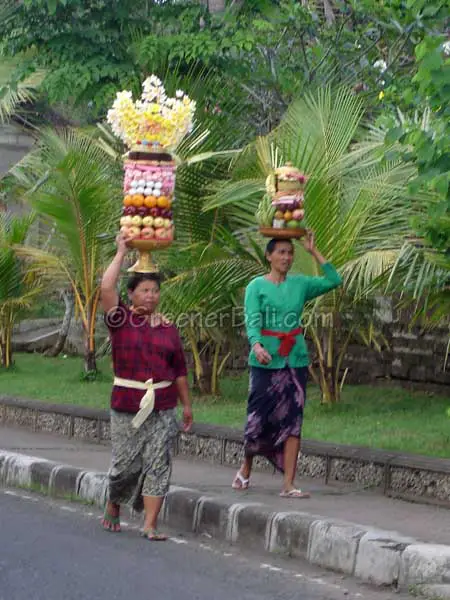
Besides all the festivals mentioned earlier, there is the Odalan, the annual temple birthday. This ‘birthday’ is celebrated every year according to the Wuku Calendar. So this means every 210 days.
During the Odalan celebrations will take place accompanied by many purification ceremonies. Depending on the size of the temple and its importance the Odalan festival can attract a small gathering or it could be that thousands of people come together.
You can find a huge crowd of people from all over Bali at Pura Besakih, the mother temple. It results in a colorful spectacle, unlike anything you have ever seen…
Each village has at least three temples. So in total, one village alone has 5 or 6 Odalan festivals a year.
4. Other temple ceremonies
Balinese temple ceremonies can also take place according to the position of the moon: the new moon (night of complete darkness) or the new moon.
Other festivals that take place throughout the island are temple festivities dedicated to specific gods. During these days the Pemangku, temple guardian and priest for temple rituals, will invite the gods to come to the temple for a visit.
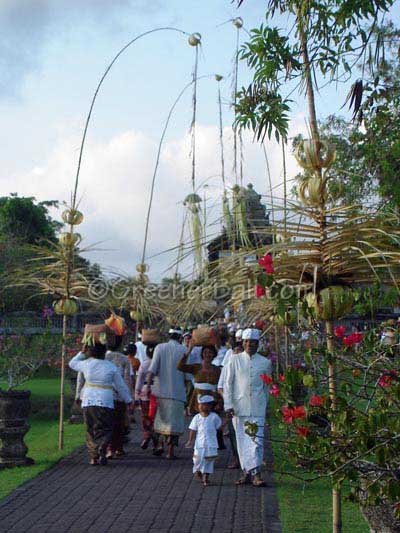
During this cultural event, the gods will occupy the little thrones at the temple sight while the people will dance and play music all day long until the Pemangku suggests that the gods return to heaven.
It’s not that difficult to spot if something important is going on at a temple. Groups of women will gather at the temple carrying high towers of fruit and flower offerings on their heads. As you can imagine always a beautiful sight to watch.
Foreigners who are interested in these temple activities are welcome to have a look and take pictures after approval. However, it is required to dress accordingly: long sleeves, sarong and a ceremonial sash tied around the waist.
5. Other annual events
Besides all the festivals mentioned above, there are smaller events dedicated to a specific god as well. Here is a couple of them:
Saraswati – annual Balinese event to honor the Goddess of Knowledge.
This is celebrated on the last day of the Wuku year. On this day books are worshiped and there will be no reading. Students pray for success in their studies.
Tumpek Kandang – the blessing of animals
Tumpek Landep – the blessing of objects made of metal such as tools, cars, motorbikes, cars, you name it.
Until today I am still amazed about the number of festivals. There is really one for almost every occasion.
But in a way, it feels like the Balinese are more conscious of their surroundings, social and family responsibilities and above all life itself.
It creates a harmonious and balanced image that makes Bali what it is today.
And the unique thing about these festivals is that it can only be seen in Bali alone. So for anybody who visits this beautiful island, it will be a great experience to remember.

